The Effects of the Spatial Extent on Modelling Giant Panda Distributions Using Ecological Niche Models
Abstract
:1. Introduction
2. Materials and Methods
2.1. Introduction to Model
2.2. Case Study Area and Research Extent
2.3. Data Collection
2.4. Model Construction
3. Results
3.1. Model Prediction Accuracy Test
3.2. Distribution of Predicted Suitable Areas for the Giant Panda
3.3. Contribution and Importance of Environmental Predictors
3.4. Response Curve
4. Discussion
4.1. Model Results Will Be Affected by Errors in the Data Collection
4.2. The Predicted Suitable Areas Are Different at Different Modelling Extents
4.3. Human Interference Factors Need to Be Considered
4.4. The Contribution Rate of Environmental Variables and Response Curves under Different Modelling Spatial Extents Can Provide New Ideas for Protecting Giant Pandas
- (1)
- The local managers of each protected area or county in the MMS should pay attention to the management and restriction of human activities on a small scale. Even though the setting scale of this study is too big to identify the influence of human interference, it can be seen from other literature combined with the model result that human interference has actual impacts on the habitat of giant pandas. For example, the effect of increased grazing needs to be taken seriously by local managers to alleviate the compression of the giant pandas’ natural habitat.
- (2)
- Managers of relevant departments of the entire MMS area can refer to the environmental contribution rate, and response curve at the MMS extent to take protective measures. For instance, they can monitor the dynamic changes from the factors of ‘changes in daily average temperature’ and ‘precipitation in the driest month’ to ensure that the giant pandas’ habitat has the correct living conditions. The monitoring and control of these environmental variables can more effectively improve the protection capability within the scope of the Min Mountain System. In addition, monitoring points can be set up in areas that are within the pandas’ suitable distance to a water source to improve wild panda investigation and monitoring efficiency.
- (3)
- From a national macro-scale, national environmental protection organisations and national core ecological protection agencies should adopt macro-monitoring of factors with high contribution rates at large scales to control the fragmentation and degradation of the giant pandas’ habitat, for example, monitoring annual precipitation and annual temperature differences.
5. Conclusions
Author Contributions
Funding
Institutional Review Board Statement
Informed Consent Statement
Data Availability Statement
Acknowledgments
Conflicts of Interest
References
- Zang, C.; Cai, L.; Li, J.; Wu, X.; Li, X.; Li, J. Preparation of the China Biodiversity Red List and Its Significance for Biodiversity Conservation within China. Biodivers. Sci. 2016, 24, 610–614. [Google Scholar] [CrossRef]
- Wei, F.; Zhang, Z.; Hu, J. Research Advances and Perspectives on the Ecology of Wild Giant Pandas. ACTA Ecol. Sin. 2011, 31, 412–421. [Google Scholar]
- Hu, J.; Schaller, G.; Pan, W.; Zhu, J. Wolong Giant Panda; Sichuan Science and Technology Press: Chengdu, China, 1985; pp. 25–40. [Google Scholar]
- Zhou, S.; Qu, Y.; Huang, J.; Huang, Y.; Li, D.; Zhang, H. A Summary of Researches on the Wild Giant Panda Population Dynamics. J. Sichuan For. Sci. Technol. 2017, 38, 17–30. [Google Scholar] [CrossRef]
- Zhen, J. Fine-Scale Evaluation of Giant Panda Habitats and Countermeasures against the Impacts of Future Climate Change. Ph.D. Thesis, Chinese Academy of Sciences University, Beijing, China, 2018. [Google Scholar]
- Forestry and Grassland Administration Results of The Fourth National Giant Panda Survey Announced_Current Affairs Information_State Forestry and Grassland Administration Government Website. Available online: http://www.forestry.gov.cn/main/304/20150302/758246.html (accessed on 4 August 2020).
- WWF Topics in The Fourth National Giant Panda Survey. Available online: http://www.wwfchina.org/specialdetail.php?pid=205&page=13 (accessed on 4 August 2020).
- Hull, V.; Zhang, J.; Zhou, S.; Huang, J.; Viña, A.; Liu, W.; Tuanmu, M.-N.; Li, R.; Liu, D.; Xu, W.; et al. Impact of Livestock on Giant Pandas and Their Habitat. J. Nat. Conserv. 2014, 22, 256–264. [Google Scholar] [CrossRef]
- Linderman, M.A.; An, L.; Bearer, S.; He, G.; Ouyang, Z.; Liu, J. Modeling the Spatio-Temporal Dynamics and Interactions of Households, Landscapes, and Giant Panda Habitat. Ecol. Model. 2005, 183, 47–65. [Google Scholar] [CrossRef]
- Zhang, Z.; Li, W.; Zhang, M.; Liu, D. Study on Sustainable Development Strategies of the Giant Panda Nature Reserve in New Period. For. Resour. Manag. 2018, 5, 1–7. [Google Scholar] [CrossRef]
- Peng, W.; Wang, X. Concept and connotation development of niche and its ecological orientation. Ying Yong Sheng Tai Xue Bao J. Appl. Ecol. 2016, 27, 327–334. [Google Scholar]
- Hu, J. The “Most” of Giant Panda. Wild Anim. 1984, 1–5. [Google Scholar] [CrossRef]
- Zhang, Q. Study on Habitat Selection of Giant Panda in Minshan, Gansu. Master’s Thesis, Northwest Normal University, Lanzhou, China, 2009. [Google Scholar]
- Li, R.; Xu, M.; Wong, M.H.G.; Qiu, S.; Li, X.; Ehrenfeld, D.; Li, D. Climate Change Threatens Giant Panda Protection in the 21st Century. Biol. Conserv. 2015, 182, 93–101. [Google Scholar] [CrossRef]
- Kumar, S.; Graham, J.; West, A.M.; Evangelista, P.H. Using District-Level Occurrences in MaxEnt for Predicting the Invasion Potential of an Exotic Insect Pest in India. Comput. Electron. Agric. 2014, 103, 55–62. [Google Scholar] [CrossRef]
- Qiao, H.; Huang, J.; Hu, J. Theoretical Basis, Future Directions, and Challenges for Ecological Niche Models. Sci. Sin. Vitae 2013, 43, 915–927. [Google Scholar] [CrossRef]
- Zhuang, H.; Zhang, Y.; Wang, W.; Ren, Y.; Liu, F.; Du, J.; Zhou, Y. Optimized Hot Spot Analysis for Probability of Species Distribution under Different Spatial Scales Based on MaxEnt Model: Manglietia Insignis Case. Biodivers. Sci. 2018, 26, 913–920. [Google Scholar] [CrossRef] [Green Version]
- Connor, T.; Viña, A.; Winkler, J.A.; Hull, V.; Tang, Y.; Shortridge, A.; Yang, H.; Zhao, Z.; Wang, F.; Zhang, J.; et al. Interactive Spatial Scale Effects on Species Distribution Modeling: The Case of the Giant Panda. Sci. Rep. 2019, 9, 14563. [Google Scholar] [CrossRef] [Green Version]
- Liao, Y.; Wang, X.; Zhou, J. Suitability Assessment and Validation of Giant Panda Habitat Based on Geographical Detector. J. Geo-Inf. Sci. 2016, 18, 767–778. [Google Scholar]
- Luo, M.; Wang, H.; Lyu, Z. Evaluating the performance of species distribution models Biomod2 and MaxEnt using the giant panda distribution data. Ying Yong Sheng Tai Xue Bao J. Appl. Ecol. 2017, 28, 4001–4006. [Google Scholar] [CrossRef]
- Tang, C. Giant Panda Habitat, Where Do Giant Pandas Live in China, Panda Habitat Protection. Available online: https://www.chinahighlights.com/giant-panda/habitat.htm (accessed on 16 July 2020).
- Xu, Z.; Peng, H.; Peng, S. The Development and Evaluation of Species Distribution Models. Acta Ecol. Sin. 2015, 35. [Google Scholar] [CrossRef] [Green Version]
- Phillips, S.J.; Anderson, R.P.; Schapire, R.E. Maximum Entropy Modeling of Species Geographic Distributions. Ecol. Model. 2006, 190, 231–259. [Google Scholar] [CrossRef] [Green Version]
- Liu, Y. Effect of Climate Change on Giant Pandas and Habitats in the Minshan Mountains. Master’s Thesis, Beijing Forestry University, Beijing, China, 2012. [Google Scholar]
- Global Biodiversity Information Facility. Available online: https://www.gbif.org/ (accessed on 20 June 2020).
- National Specimen Information Infrastructure. Available online: http://www.nsii.org.cn/2017/home.php (accessed on 20 June 2020).
- WORLDCLIM. Available online: https://www.worldclim.org/ (accessed on 20 June 2020).
- Resource and Environment Data Center of the Chinese Academy of Sciences. Available online: http://www.resdc.cn/ (accessed on 20 June 2020).
- Synes, N.W.; Osborne, P.E. Choice of Predictor Variables as a Source of Uncertainty in Continental-Scale Species Distribution Modelling under Climate Change: Predictor Uncertainty in Species Distribution Models. Glob. Ecol. Biogeogr. 2011, 20, 904–914. [Google Scholar] [CrossRef]
- Guisan, A.; Zimmermann, N.E. Predictive Habitat Distribution Models in Ecology. Ecol. Model. 2000, 135, 147–186. [Google Scholar] [CrossRef]
- Guisan, A.; Thuiller, W. Predicting Species Distribution: Offering More than Simple Habitat Models. Ecol. Lett. 2005, 8, 993–1009. [Google Scholar] [CrossRef]
- Phillips, S.J.; Dudík, M.; Schapire, R.E. Maxent Software for Modeling Species Niches and Distributions. Available online: https://biodiversityinformatics.amnh.org/open_source/maxent/ (accessed on 19 May 2020).
- Bradie, J.; Leung, B. A Quantitative Synthesis of the Importance of Variables Used in MaxEnt Species Distribution Models. J. Biogeogr. 2017, 44, 1344–1361. [Google Scholar] [CrossRef]
- Fielding, A.H.; Bell, J.F. A Review of Methods for the Assessment of Prediction Errors in Conservation Presence/Absence Models. Environ. Conserv. 1997, 24, 38–49. [Google Scholar] [CrossRef]
- Liu, C.; White, M.; Newell, G. Measuring and Comparing the Accuracy of Species Distribution Models with Presence-Absence Data. Ecography 2011, 34, 232–243. [Google Scholar] [CrossRef]
- Yang, N.; Ma, D.; Zhong, X.; Yang, K.; Zhou, Z.; Zhou, H.; Zhou, C.; Wang, B. Habitat Suitability Assessment of Blue Eared-Pheasant Based on MaxEnt Modeling in Wanglang National Nature Reserve, Sichuan Province. Acta Ecol. Sin. 2020, 40, 1–9. [Google Scholar]

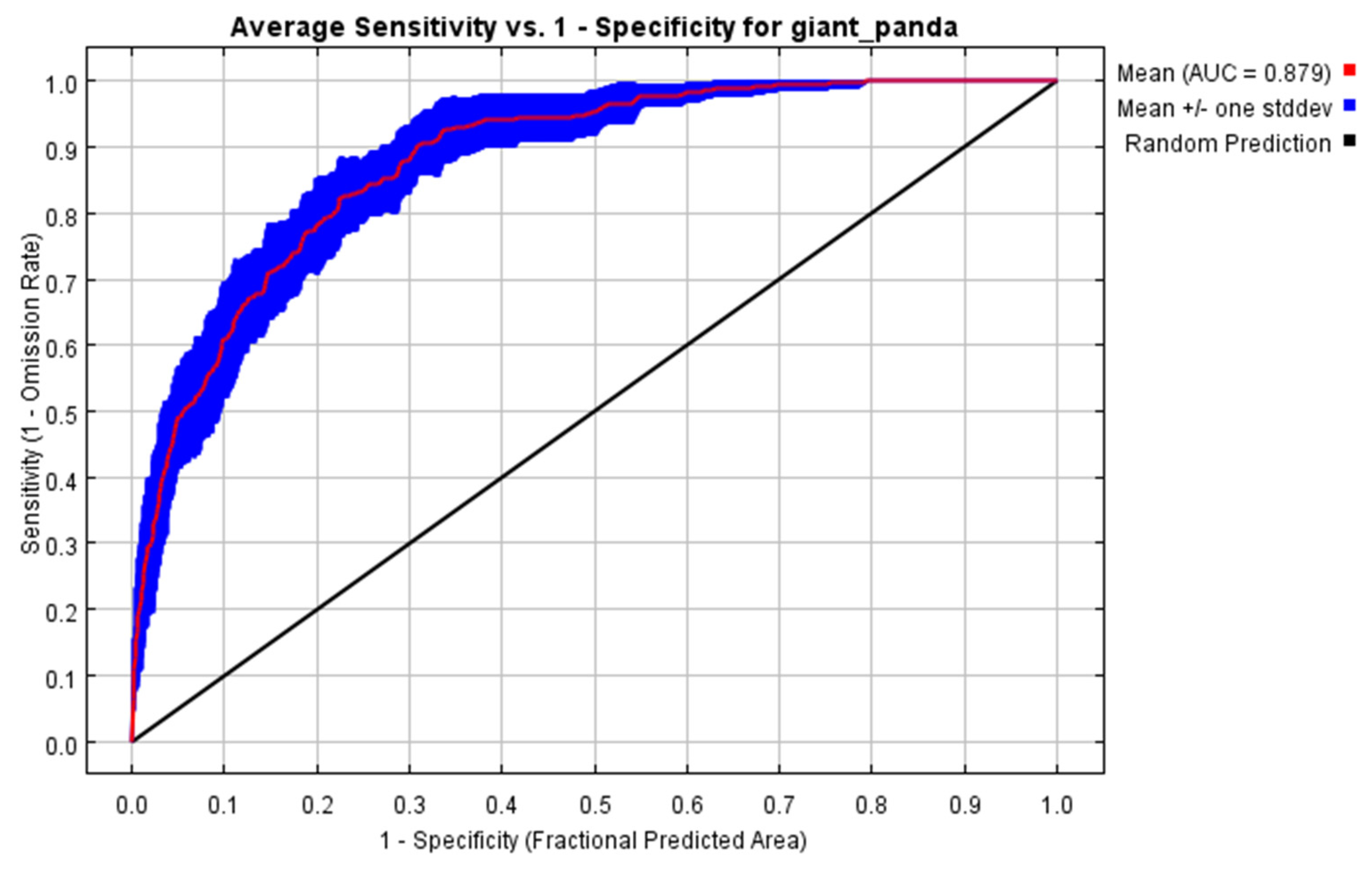
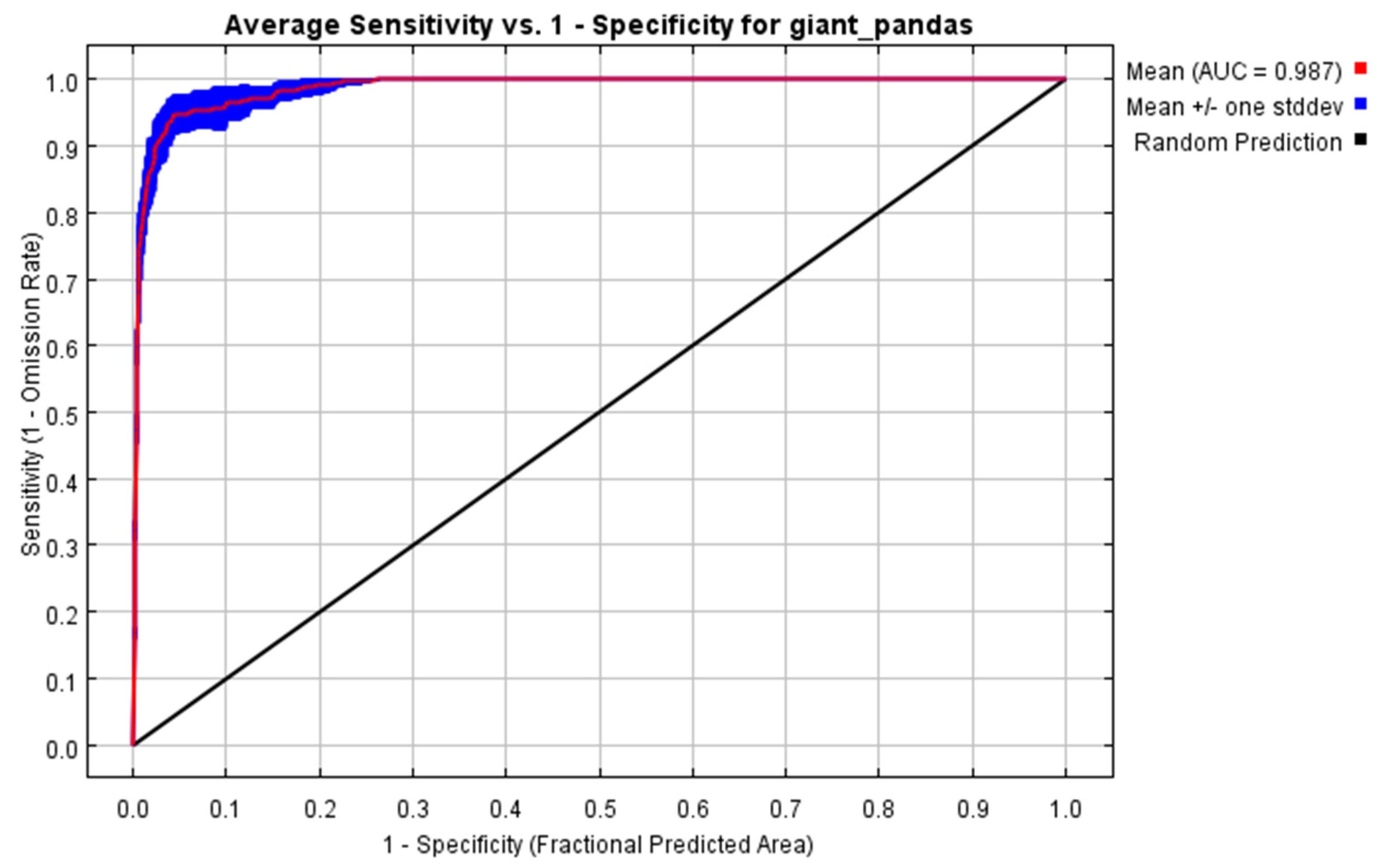
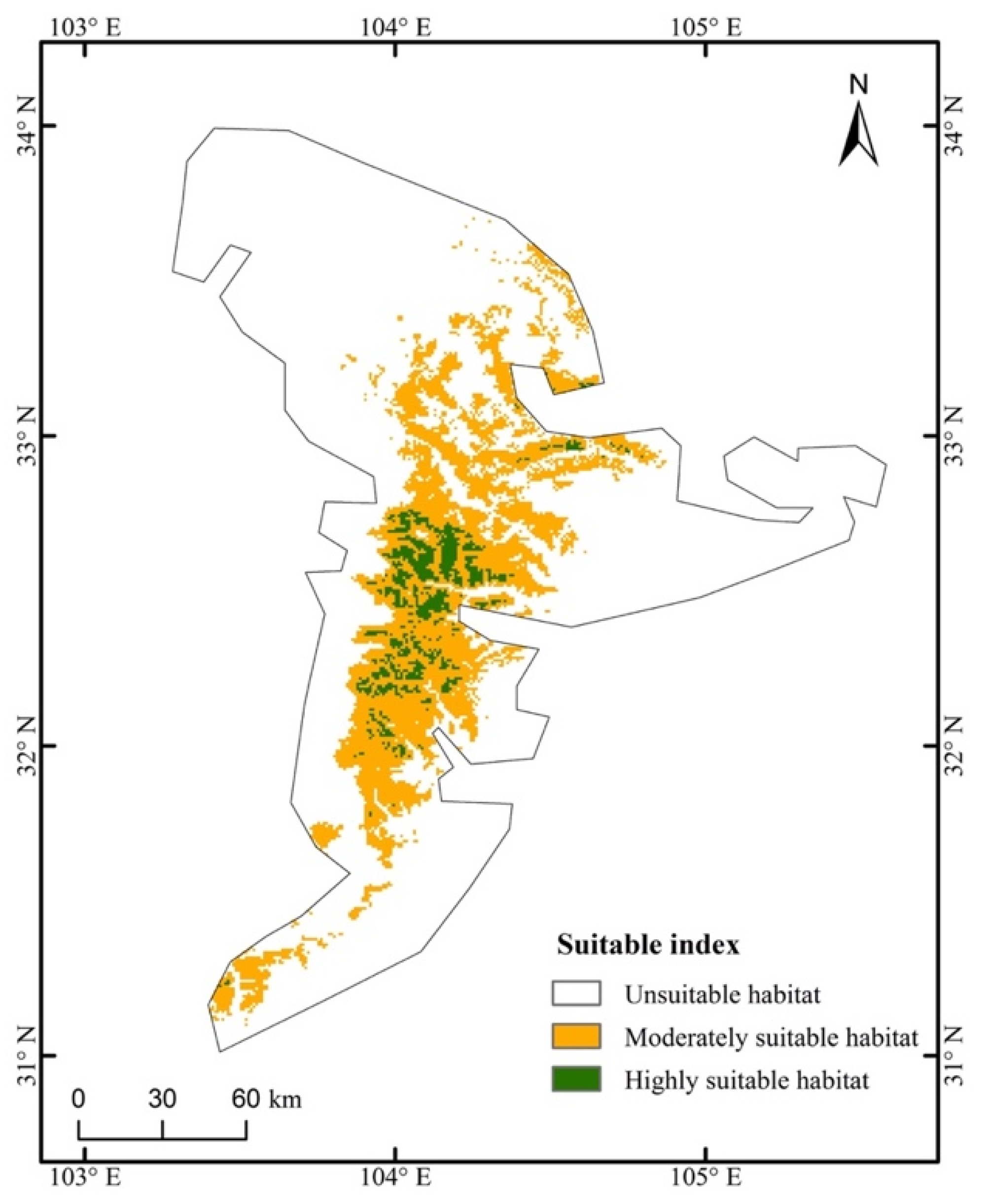
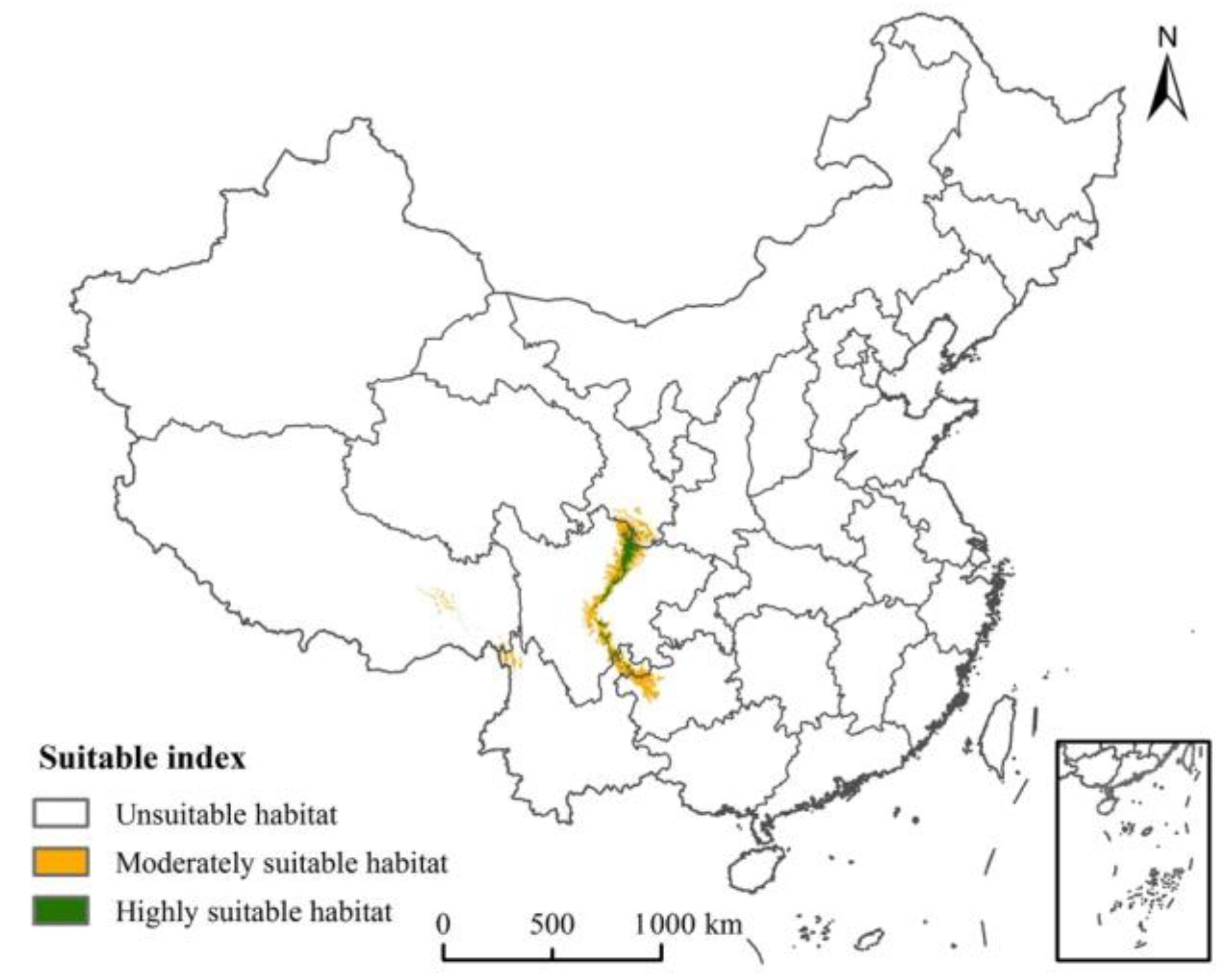
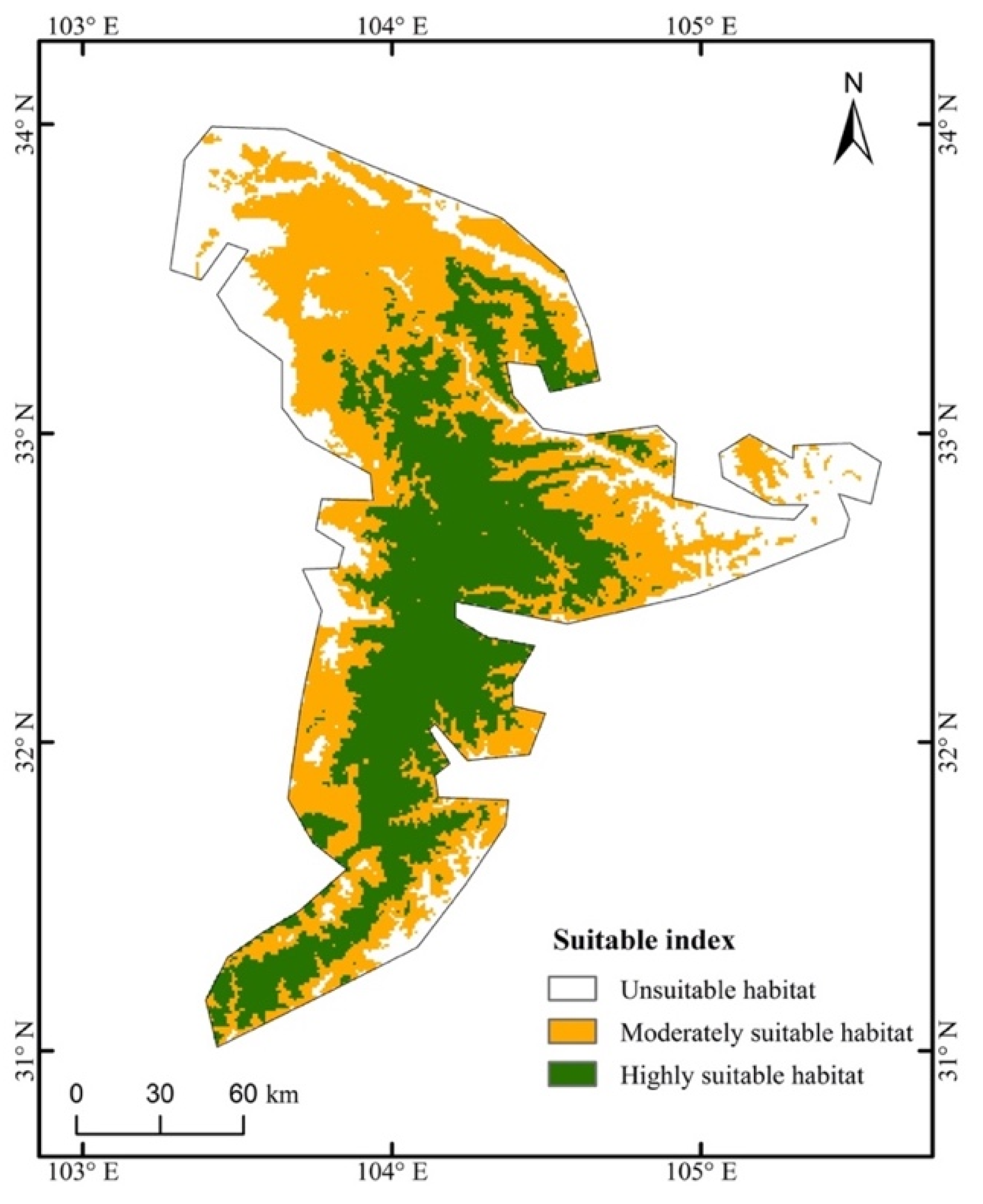
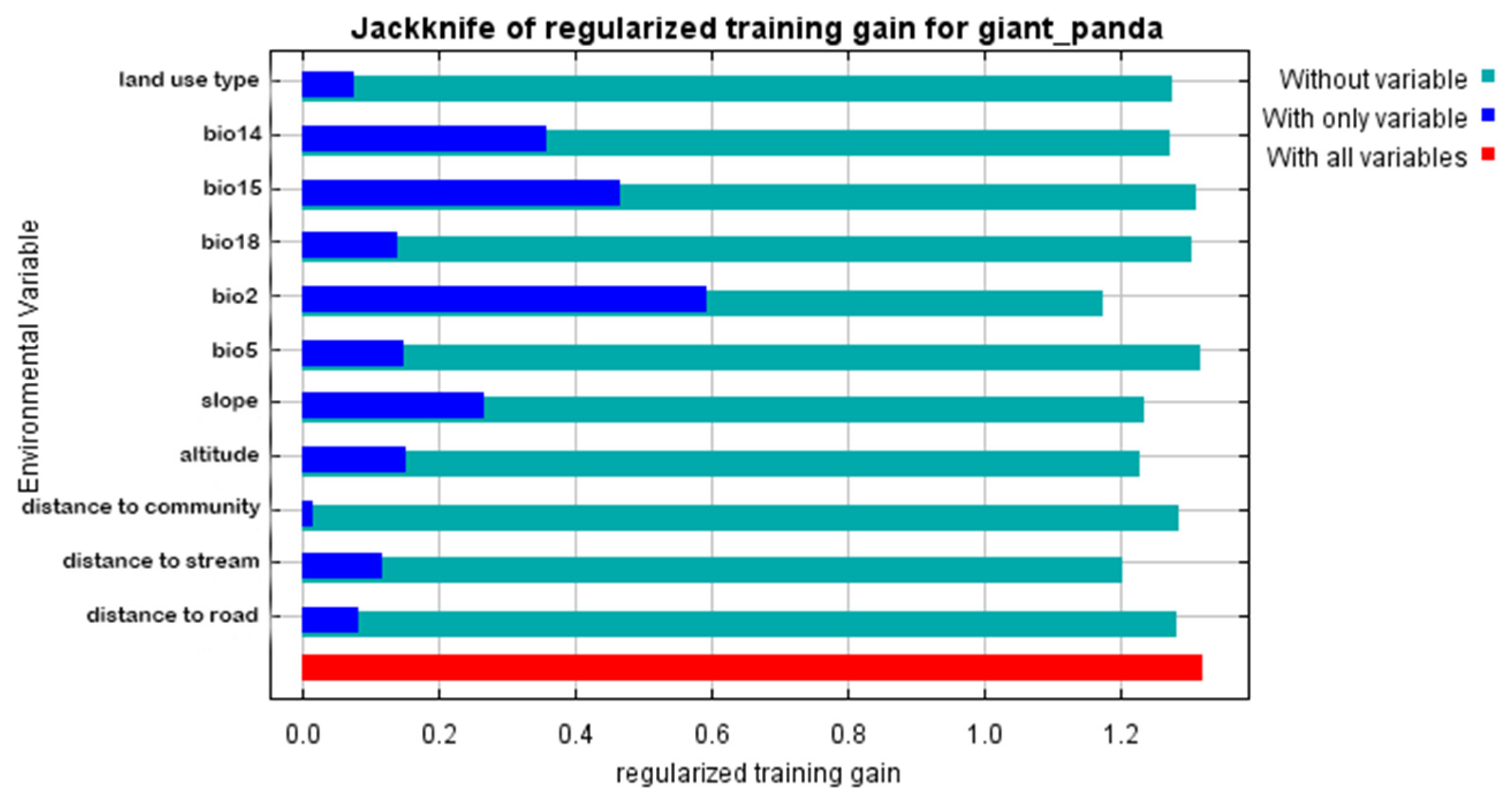
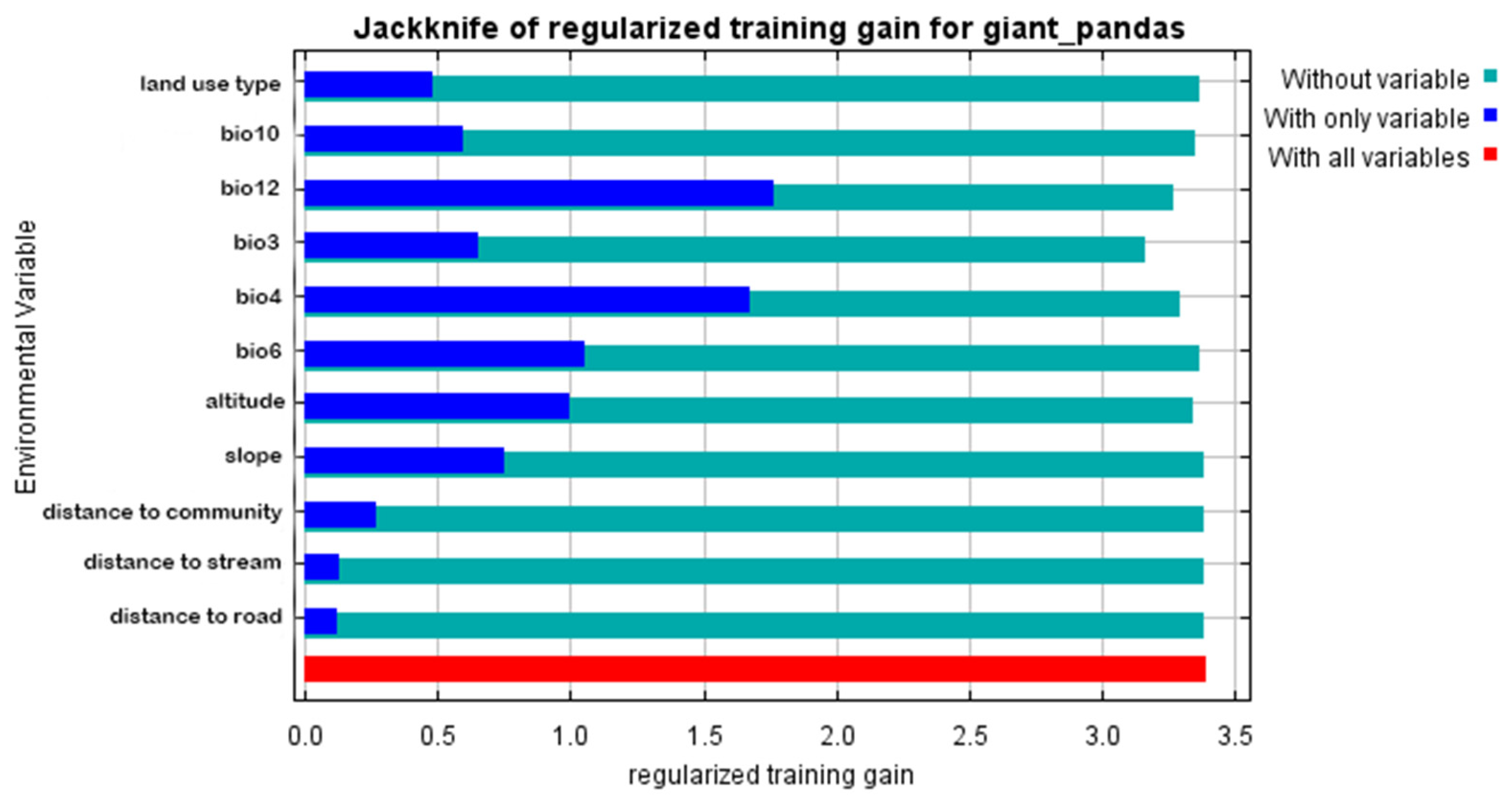

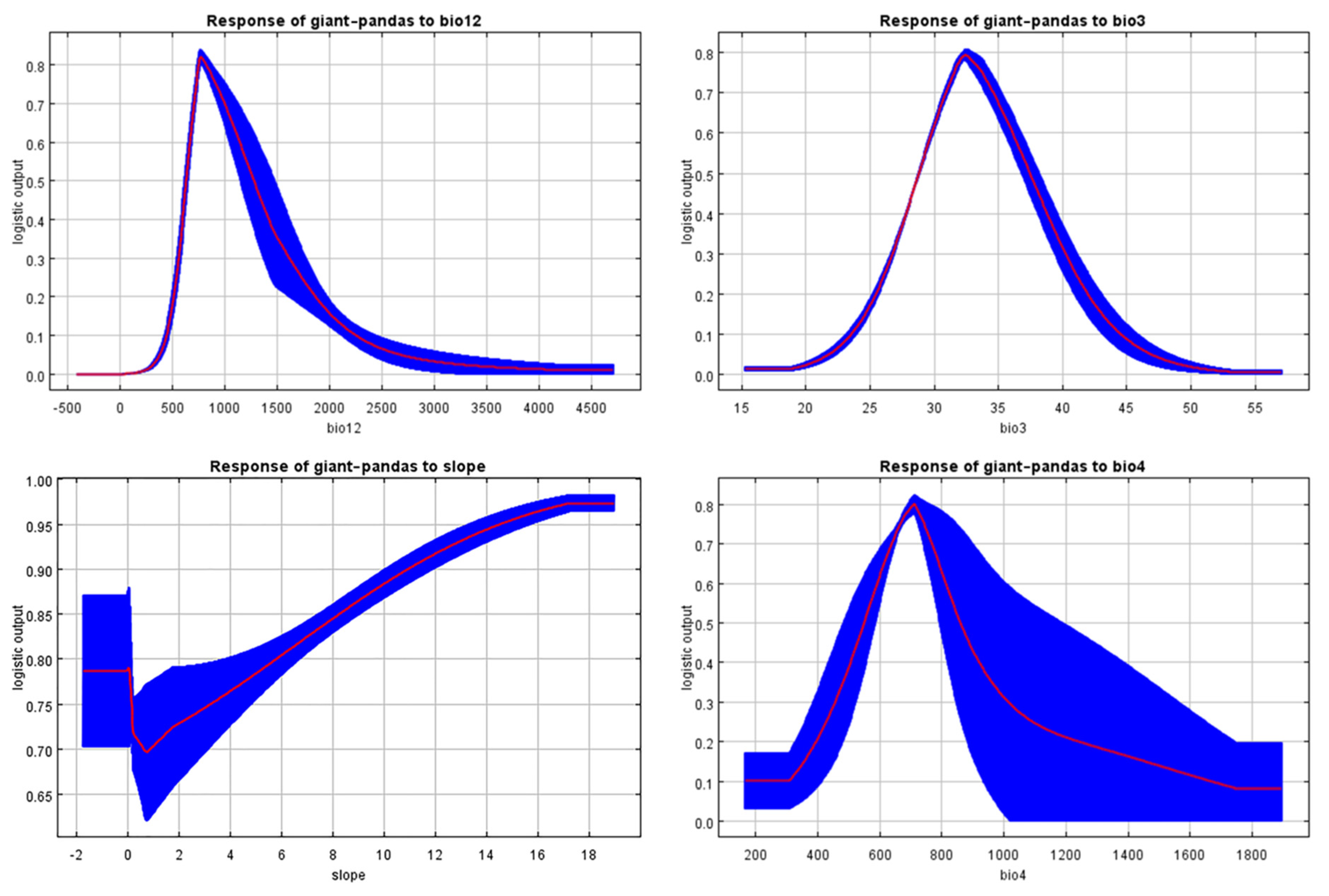
| Mountain Systems | Area/hm2 | Percentage of Total Habitat/% | Administrative Regions/Province |
|---|---|---|---|
| The Qinling Mountain | 352,914 | 15.31 | Shaanxi, Gansu |
| The Min Mountain | 960,313 | 41.66 | Sichuan, Gansu |
| The Qionglai Mountain | 610,122 | 26.47 | Sichuan |
| The Daxiangling Mountain | 81,026 | 3.52 | Sichuan |
| The Xiaoxiangling Mountain | 80,204 | 3.48 | Sichuan |
| The Liang Mountain | 220,412 | 9.56 | Sichuan |
| Total | 2,304,991 | 100 |
| Index | Description |
|---|---|
| Bio1 | Mean annual temperature |
| Bio2 | Mean diurnal air temperature range |
| Bio3 | Isothermality (Bio2/Bio7 × 100) |
| Bio4 | The standard deviation of temperature seasonality |
| Bio5 | Max temperature of the warmest month |
| Bio6 | Min. temperature of the coldest month |
| Bio7 | Temperature annual range (Bio5-Bio6) |
| Bio8 | Mean temperature of the wettest quarter |
| Bio9 | Mean temperature of the driest quarter |
| Bio10 | Mean temperature of the warmest quarter |
| Bio11 | Mean temperature of the coldest quarter |
| Bio12 | Annual precipitation |
| Bio13 | Precipitation of the wettest month |
| Bio14 | Precipitation of the driest month |
| Bio15 | Coefficient of variation of precipitation seasonality |
| Bio16 | Precipitation of the wettest quarter |
| Bio17 | Precipitation of the driest quarter |
| Bio18 | Precipitation of the warmest quarter |
| Bio19 | Precipitation of the coldest quarter |
| Region | Variables | Contribution (%) | Region | Variables | Contribution (%) |
|---|---|---|---|---|---|
| Min Mountain extent | Bio2 | 25 | Country extent | Bio3 | 23.4 |
| Bio5 | 0.8 | Bio4 | 3.6 | ||
| Bio14 | 5.4 | Bio6 | 2.4 | ||
| Bio15 | 30.1 | Bio10 | 1.1 | ||
| Bio18 | 0.8 | Bio12 | 34.4 | ||
| Slo | 6 | Slo | 19.6 | ||
| Alt | 9.1 | Alt | 14.3 | ||
| DTC | 2 | DTC | 0.2 | ||
| DTS | 12.9 | DTS | 0.3 | ||
| DTR | 5.3 | DTR | 0.1 |
Publisher’s Note: MDPI stays neutral with regard to jurisdictional claims in published maps and institutional affiliations. |
© 2021 by the authors. Licensee MDPI, Basel, Switzerland. This article is an open access article distributed under the terms and conditions of the Creative Commons Attribution (CC BY) license (https://creativecommons.org/licenses/by/4.0/).
Share and Cite
Huang, Z.; Huang, A.; Dawson, T.P.; Cong, L. The Effects of the Spatial Extent on Modelling Giant Panda Distributions Using Ecological Niche Models. Sustainability 2021, 13, 11707. https://doi.org/10.3390/su132111707
Huang Z, Huang A, Dawson TP, Cong L. The Effects of the Spatial Extent on Modelling Giant Panda Distributions Using Ecological Niche Models. Sustainability. 2021; 13(21):11707. https://doi.org/10.3390/su132111707
Chicago/Turabian StyleHuang, Ziye, Anmin Huang, Terence P. Dawson, and Li Cong. 2021. "The Effects of the Spatial Extent on Modelling Giant Panda Distributions Using Ecological Niche Models" Sustainability 13, no. 21: 11707. https://doi.org/10.3390/su132111707





